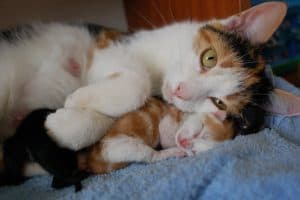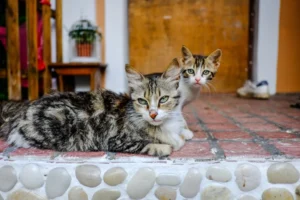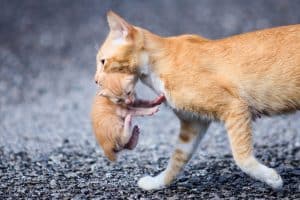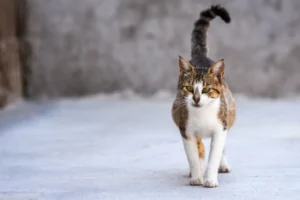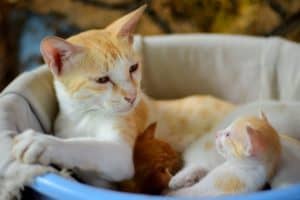Cats are known for their quirky behaviors, and one of the most adorable ones is when they knead stuffed animals. Have you ever wondered why they do this? Let’s take a closer look at this endearing feline behavior.
When cats knead stuffed animals, they are exhibiting a behavior that is rooted in their instincts. This kneading action, also known as “making biscuits,” is a natural behavior that starts when they are kittens nursing from their mother.
Instinctual Behavior
Kneading is a behavior deeply rooted in a cat’s instincts, harkening back to their days as nursing kittens. When kittens nurse, they use their paws to massage the mother cat’s belly, stimulating milk flow. This action of pressing and releasing is imprinted in their memory as a comforting and familiar behavior. So, when your cat kneads their stuffed animal, it’s simply a natural instinct kicking in.
Comfort and Security
Cats often knead soft objects like blankets, pillows, or stuffed animals as a way to create a cozy and secure space. This repetitive motion helps them relax and can bring about a sense of comfort similar to how a baby sucks their thumb for soothing. When your cat kneads their stuffed animal, it’s a way for them to self-soothe and feel safe in their environment.
Additionally, kneading can also mark territory, as cats have scent glands in their paw pads that release pheromones. By kneading their stuffed animal, they are claiming it as their own and creating a familiar scent that provides them with a sense of ownership and security.
Unique Insight: Cats may also knead their stuffed animals when they are feeling particularly content or happy. This behavior can be a sign that your cat is in a positive emotional state, finding comfort and joy in their beloved toy.
Scent Marking
Kneading is a natural behavior for cats, and when they do it on stuffed animals, it serves a purpose beyond just comfort. Scent marking is a big reason why cats knead their favorite toys. By kneading on a stuffed animal, a cat is essentially leaving its scent behind as a way of marking its territory. This behavior is rooted in a cat’s instinct to feel more secure in its environment. So, the next time you catch your feline friend kneading on their beloved stuffed animal, know that they’re claiming it as their own in a subtle, odoriferous way.
Playfulness and Mimicking Hunting
Cats, despite their domestication, still retain many of their wild instincts, and one of these is their love for play and hunting. When cats knead on stuffed animals, it could be their way of mimicking hunting behaviors. Think of it as their way of practicing their hunting moves on a toy before going after real prey. It’s a form of playfulness that keeps them mentally and physically stimulated. So, don’t be surprised if you see your cat kneading, pouncing, and batting around their favorite stuffed animal – it’s just their natural instincts at play.
- Unique Insight: Cats may also knead stuffed animals as a way to show affection, much like how they would knead their mother’s belly while nursing as kittens. So, when your cat kneads on a stuffed animal, they are essentially expressing love and comfort towards that object.
Remember, these behaviors are perfectly normal and healthy for your feline friend. Enjoy watching them express their natural instincts through kneading on their stuffed animals!
Attention Seeking
Cats kneading stuffed animals seek attention from their owners or fellow felines. By the repetitive motion of pushing and pulling with their paws, cats often elicit a response from those around them. This behavior could stem from a desire for interaction or simply a way to communicate their presence. If your furry friend is kneading their stuffed toy, it might be their way of saying, “Hey, I’m here, let’s hang out!”
Emotional Connection
In some cases, cats develop an emotional connection to their stuffed animals through kneading. Similar to how humans bond with comfort objects, cats may find solace and security in their plush companions. This bonding process can provide them with a sense of familiarity and comfort, especially in times of stress or loneliness. So, if you notice your cat kneading their favorite stuffed animal, it could be their way of seeking emotional support and connection.
Pro-tip: To encourage a deeper emotional bond with your cat, consider incorporating their favorite stuffed animal into special play sessions or cuddle time. This can strengthen the bond between you and your feline friend, creating a sense of security and comfort for them.
Stress Relief
Cats kneading stuffed animals is often a sign of stress relief. Just like how we might squeeze a stress ball or massage our temples, cats kneading helps them relax and unwind. This behavior traces back to kittenhood when they kneaded their mother’s belly to stimulate milk flow and feel safe. So, when your furball is feeling anxious or tense, kneading can be their way of self-soothing. It’s like their version of a calming ritual. So, if you catch your kitty kneading their favorite stuffed animal, it might be their way of finding comfort in a big, fluffy hug.
Can It Be Harmful?
While kneading itself isn’t harmful, there are potential risks if your feline friend starts nibbling on or ingesting the fibers or materials of the stuffed animal. This could lead to intestinal blockages or other digestive issues. To prevent this, make sure the stuffed animal is made of safe, non-toxic materials, and supervise your cat while they knead. If your cat shows a tendency to chew on their stuffed animal, it might be best to provide them with safer alternatives like a catnip toy or a chew toy. Remember, a happy kneading session shouldn’t turn into a trip to the vet.
Additional Insight:
– Providing your cat with a designated kneading spot, like a soft blanket or cushion, can redirect their kneading behavior from stuffed animals to a more appropriate item. This way, you can ensure your cat’s safety and keep their kneading habits in check.
Interactive Toys
If your cat loves kneading stuffed animals, consider providing them with some alternative interactive toys that can offer similar benefits. Catnip-filled toys can be a great option as the scent of catnip can be very appealing to cats and provide them with a similar sensory experience to kneading. Feather wands or interactive laser toys can also engage your cat’s natural hunting instincts and provide a fun and stimulating playtime. Puzzle feeders are another excellent choice as they can keep your cat mentally stimulated and provide a rewarding challenge. Remember, each cat has their own preferences, so try out a few different options to see what captures your feline friend’s interest.
Fun Facts About Cat Behavior
Did you know that cats knead stuffed animals as a remnant behavior from kittenhood when they kneaded their mother’s belly to stimulate milk flow? This instinctual behavior is comforting to cats and can help them feel secure and relaxed. Another interesting fact is that kneading can also mark territory as cats have scent glands in their paws, leaving their scent on their favorite stuffed animals. So, the next time you see your cat kneading their stuffed toy, know that it’s a natural behavior that can bring them comfort and a sense of familiarity.
Unique Insight: Cats might also knead stuffed animals as a way to stretch and flex their muscles. This repetitive motion can help keep their paws and claws healthy and strong, similar to how humans might stretch when they wake up in the morning.
Remember, understanding your cat’s behavior can strengthen your bond and lead to a happier and healthier relationship with your feline companion.
Alex, a passionate animal lover, has experience in training and understanding animal behavior. As a proud pet parent to two dogs and three cats, he founded AnimalReport.net to share insights from animal experts and expand his knowledge of the animal kingdom.


